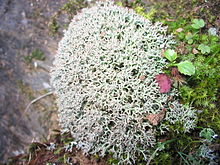| Cladonia stellaris | |
|---|---|

| |
| Scientific classification | |
| Domain: | Eukaryota |
| Kingdom: | Fungi |
| Division: | Ascomycota |
| Class: | Lecanoromycetes |
| Order: | Lecanorales |
| Family: | Cladoniaceae |
| Genus: | Cladonia |
| Species: | C. stellaris
|
| Binomial name | |
| Cladonia stellaris | |
| Synonyms | |
| |
Cladonia stellaris or the star-tipped cup lichen[1] is an ecologically important species of cup lichen that forms continuous mats over large areas of the ground in boreal and arctic regions around the circumpolar north. The species is a preferred food source of reindeer and caribou during the winter months,[2][3][4] and it has an important role in regulating nutrient cycling and soil microbiological communities.[5] Like many other lichens, Cladonia stellaris is used by humans directly for its chemical properties, as many of the secondary metabolites are antimicrobial (e.g., Usnic acid), but it also has the unique distinction of being harvested and sold as 'fake trees' for model train displays.[6] It is also used as a sound absorber in interior design.[7] The fungal portion of Cladonia stellaris, known as a mycobiont, protects the lichen from lichenivores, superfluous solar radiation, and other kinds of stressors in their ecosystem.[8]
Cladonia stellaris is described as mat-forming and fruticose (shrub-like) in appearance, and as terrestrial, terricolous, or epigeic, because it grows on the surface of bare soil or gravel. Like most other lichens, Cladonia stellaris grows slowly, averaging less than 0.5 cm per year under good conditions.[9]
This species differs from the similar Cladonia rangiferina and Cladonia arbuscula in that it forms much more distinct cushion-shaped patches, and appears to have denser branching when viewed from above.[10]
After an online vote sponsored by the Canadian Museum of Nature, the star-tipped cup lichen was unofficially crowned Canada’s national lichen.[11]
- ^ "Standardized Common Names for Wild Species in Canada". National General Status Working Group. 2020.
- ^ Pegau, R (1969). "Effect of reindeer trampling and grazing on lichens". Journal of Range Management. 23 (2): 95–97. doi:10.2307/3896107. JSTOR 3896107.
- ^ Thomas & Hervieux (1986). "The late winter diets of barren-ground caribou in North-Central Canada". Rangifer. 1 (2): 305–310. doi:10.7557/2.6.2.663.
- ^ Cichowski, D.B. (1989). Seasonal movements, habitat use, and winter feeding ecology of woodland caribou in west-central British Columbia. MSc. thesis. Univ. B.C., Vancouver, B.C. 143 p.
- ^ Stark, Sari; Wardle, David A.; Ohtonen, Rauni; Helle, Timo; Yeates, Gregor W. (2000). "The effect of reindeer grazing on decomposition, mineralization and soil biota in a dry oligotrophic Scots pine forest". Oikos. 90 (2): 301–310. doi:10.1034/j.1600-0706.2000.900210.x. JSTOR 3547140.
- ^ Purvis, O.W. (2000). Lichens. Natural History Museum, London, U.K.
- ^ "Reindeer moss". Nordgröna. Retrieved 16 August 2022.
- ^ Asplund, J., Siegenthaler, A., Gauslaa, Y. (2017) Simulated global warming increases usnic acid but reduces perlatolic acid in the mat-forming terricolous lichen Cladonia stellaris. The Lichenologist, 49, 269-274
- ^ Thomson, J.W. (1967). The lichen genus Cladonia in North America. University of Toronto Press, Toronto, Canada.
- ^ Brodo, I. M., S. D. Sharnoff, and S. Sharnoff (2001). Lichens of North America. Yale University Press, New Haven, CT, U.S.A.
- ^ Goodyear, Sheena (May 26, 2020). "Behold the star-tipped reindeer — Canadians' top pick for a national lichen". CBC Radio. Archived from the original on July 27, 2023. Retrieved July 27, 2023.